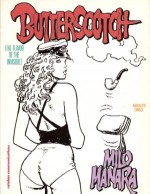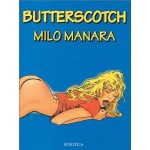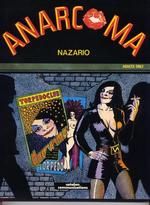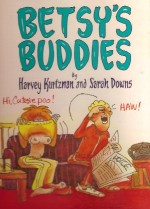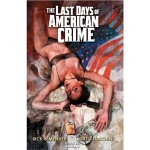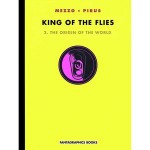
By Mezzo & Pirrus, translated by Helge Dascher with Dag Dascher & Kim Thompson (Fantagraphics)
ISBN: 978-1-60699-390-3
Scary stories are everywhere, even in the most ordinary of suburban paradises: when DC Comics started calling Alan Moore’s Swamp Thing stories “Sophisticated Suspense†in the 1980s, to differentiate them from the formulaic “Set ’em up and then go Boo!†traditions of the horror comics medium, this kind of subtle, disorienting, creeping disturbia is exactly what they were aspiring to. Cleverly constructed, laconically laid out in the classic nine-panel-grid picture structure and rendered in comfortingly mundane style a la Charles Burns, King of the Flies is a landmark in metafictional mystery tales.
In volume 1, noted crime comics creators Pascal (Mezzo) Mesenburg and Michel Pirus introduced readers to the community of Hallorave and the eponymous Eric, a very troubled young man with a predilection for donning a gigantic Fly mask. A budding sociopath, the lad is into drugs, sex (consenting and otherwise), booze, introspection and instant gratification… but in that he’s not much different from the other residents of this little slice of Heaven. He also sees dead people occasionally – and again, he’s not the only one.
The book unfolded in seemingly unconnected vignettes narrated in the first person by a broad cast of unhappy campers and this second volume of three continues the tradition, but with the disparate threads increasingly overlapping and interlocking: the inevitable denouement seemingly inescapable and darkly bloody…
‘The Origin of the Species’ opens with Eric idly daydreaming of killing his mom’s new man Francis before heading out for Marie’s place. She isn’t Eric’s girlfriend really but she is sweet and easy and despises her parents too. Things kick off when gangster reprobate Ringo shows up and tells them to look after a bag he’s carrying.
Eric is cool but Marie takes a peek, finding bundles of cash and a bowling pin inside. Later that day Eric saves an old guy from drowning because he fancied the geezers young girlfriend Karine: once again his uncontrolled desires are screwing up his life…
‘Departures/Arrivals’ follows Karine, showing her dysfunctional relationship with her bitch of a mother and how her aged lover Becker dies of a heart attack in an airport. Karine is pregnant and Eric sees opportunity…
In ‘Come Back’ we see that Damien has no luck. Not only is he killed by a genuinely remorseful drunk driver, but his last mortal sight is the three thugs who chased him to his demise and his girl screwing his best friend Eric. He’s far more mellow as a ghost though, pitying his killer and hanging out with Becker, just as dead but far less sanguine about Eric, who’s now moved on to Karine… Damien’s ex-girl Sal was always wild and she too is making use of Eric’s hound-dog ways…
‘Flesh Safari’ returns the spotlight to Eric. His stepdad is wise to him but Marie’s father still trusts him to look after his little girl. When the youngsters go to a rich kid’s party at Coralie’s place, Fly boy is set up and humiliated, but does meet a new friend in the outcast intellectual David, before spitefully punishing Marie by sleeping with his host’s mother…
‘Maternal Damage’ shows the turmoil afflicting Marie’s mother and just how close to the breaking point she is, whilst ‘Superhero’ follows Eric as Sal leads him into trouble and somebody administers a particularly efficient punishment beating. Moreover, even though Eric has done with Marie he can’t bear her seeing a new guy and inflicts some rough injustice of his own.
We learn some intriguing and unsavoury insights about David in ‘Robin Redux’ before the focus switches to Ringo: a full-throttle psychopath who isn’t happy at all when he asks for his bag back and Eric discovers somebody’s taken it…
Ringo sees ghosts too, but they are no help when his Boss Ramos gets heavy. Eric and Marie are in deep trouble until somebody intercedes from ambush and there’s one more phantom in the cast…
‘Crazy Horse’ finds Eric still haunting Karine until he has a strange and disturbing encounter with Marie’s dad and this intermediate book ends on a foreboding spiritual high note with ‘2,969 Light Years From Earth’ as Damien takes steps to protect his loved ones from an angry spirit and each other. Meanwhile, the bag thief is revealed and the repercussions of all the messed up crap the residents have been inflicting on each other is coming to a head. The doorbell rings…
…And readers will have to wait for the concluding book to discover how this stunning, mesmerising amalgam of Twin Peaks, Desert Palms, Peyton Place, The Omen and Blue Velvet plays out. A stylish and magical portmanteau saga of a community cursed with an excess of human frailty – lust, rage, greed, despair and especially shallow selfishness – this is a story that will surprise, compel, distress and haunt anybody with even half an imagination.
Darkly addictive, casually violent and graphically sexual, King of the Flies is “adults only†and well worth waiting until you’re 18 for…
© 2005 Glenat Editions/Drugstore. This edition © 2010 Fantagraphics Books. All rights reserved.

